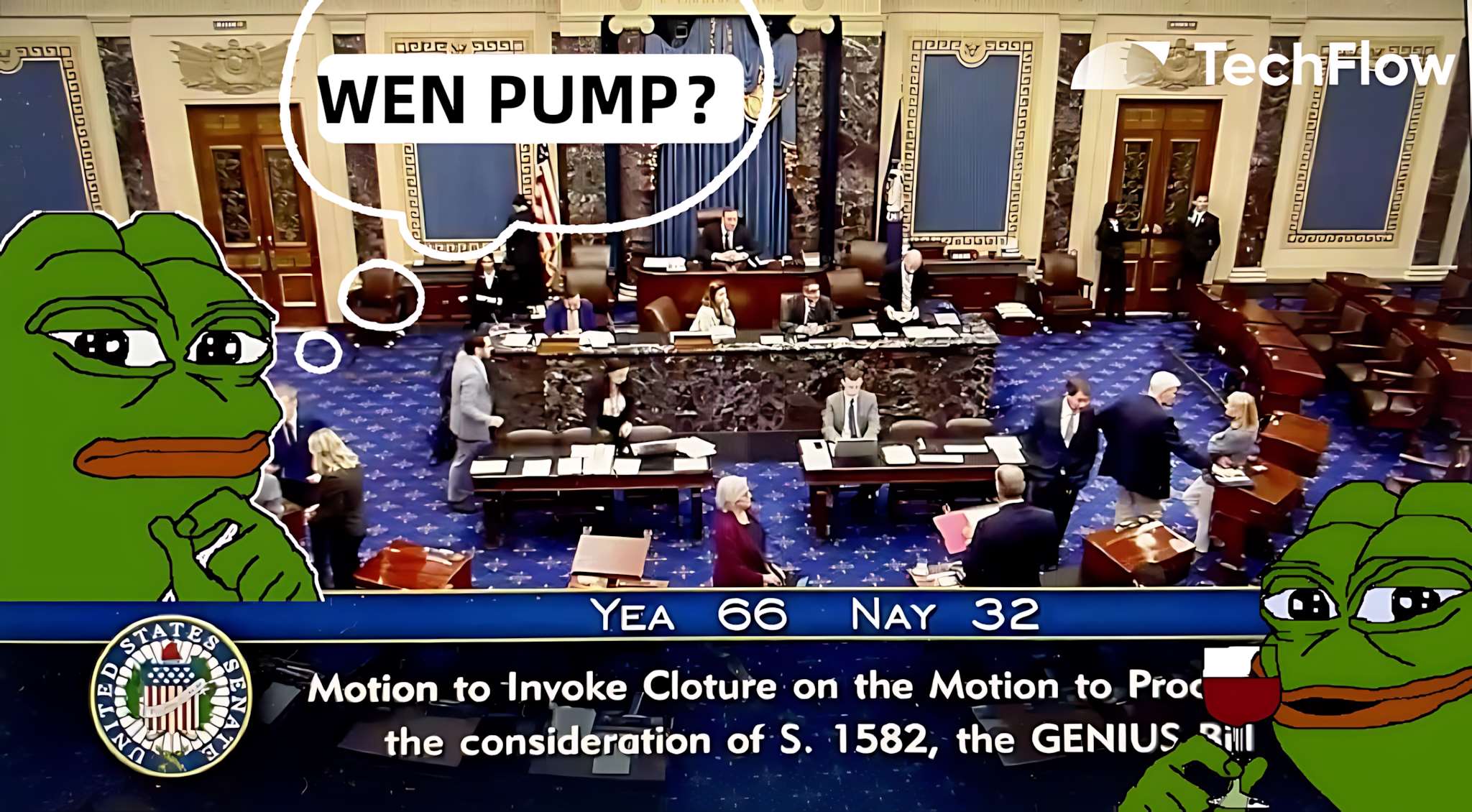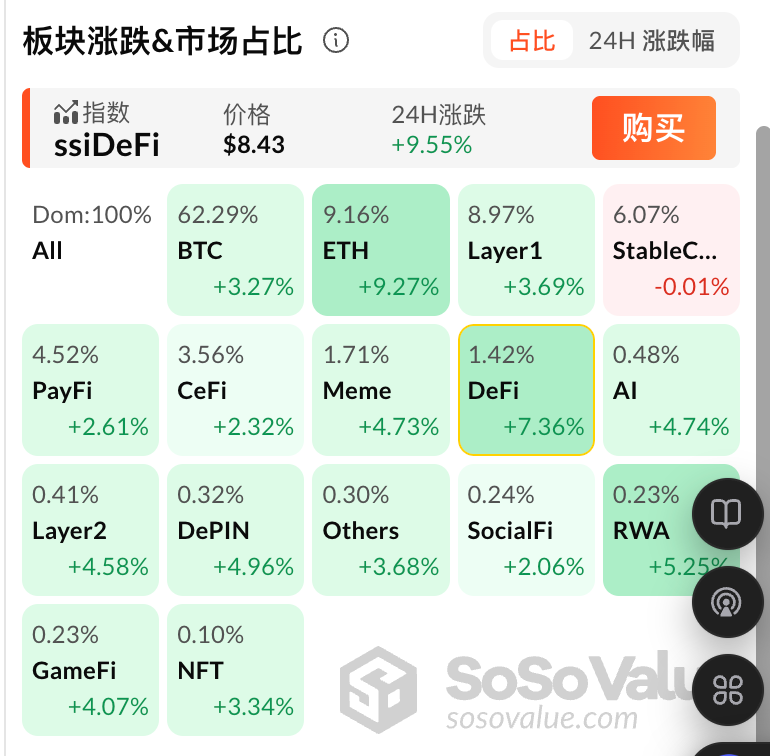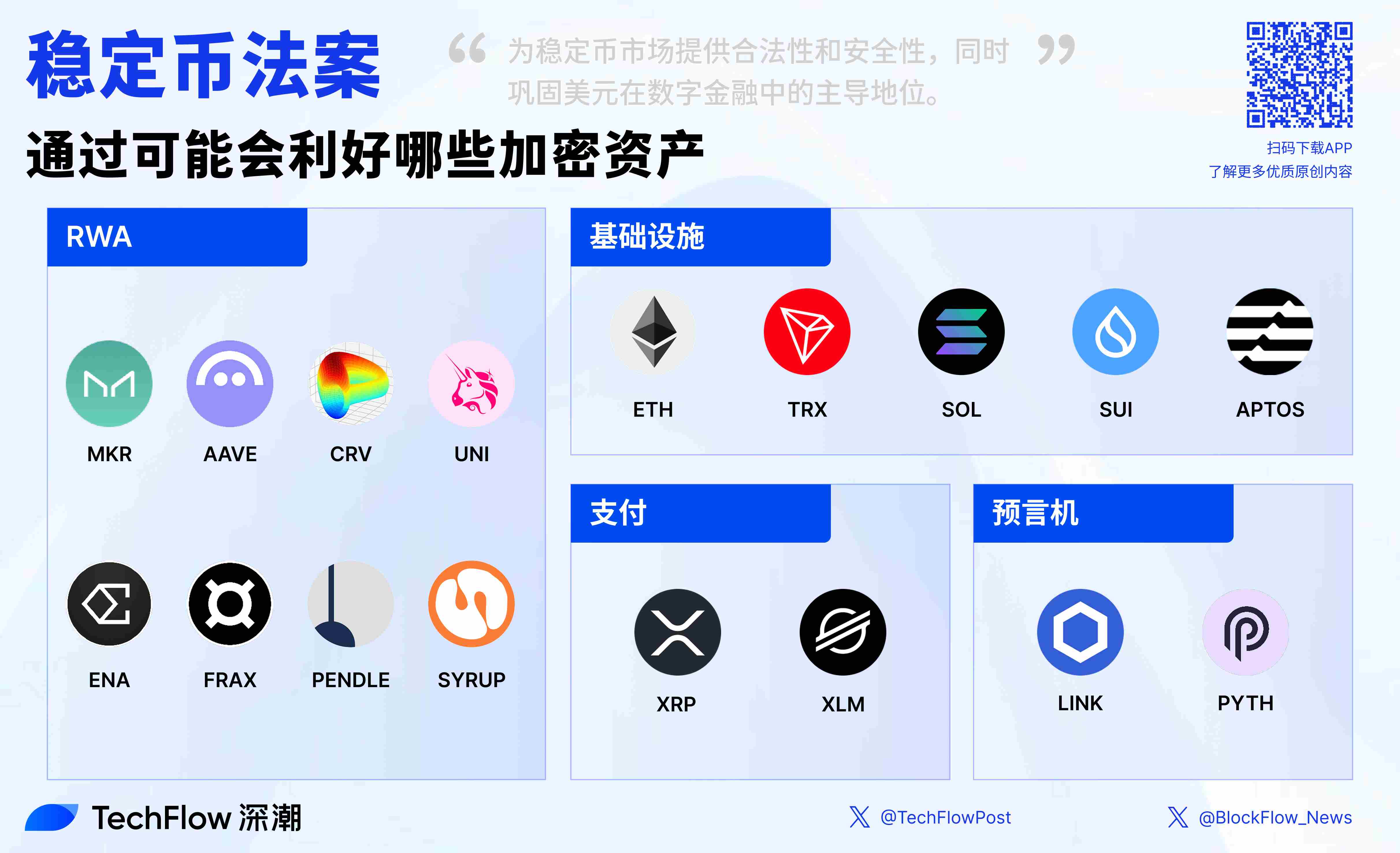The passage of the GENIUS Act provides a new path for the continuation of dollar hegemony while promoting the comprehensive prosperity of the crypto ecosystem.
Written by: Deep Tide TechFlow

The sentiment in the crypto market is once again focused on regulatory actions.
On May 19, the U.S. Senate passed the GENIUS Act (Guiding and Establishing National Innovation for U.S. Stablecoins Act of 2025) with a procedural vote of 66-32. This milestone progress marks the imminent establishment of a regulatory framework for U.S. stablecoins.
As the first comprehensive federal regulatory bill for stablecoins in U.S. history, the rapid advancement of the GENIUS Act has sparked enthusiastic reactions in the crypto market, with DeFi and RWA sectors related to stablecoins leading today's market.

Will the GENIUS Act become a catalyst for a new bull market?
According to Citibank's predictions, the global stablecoin market is expected to reach between $1.6 trillion and $3.7 trillion by 2030. The passage of the bill provides more "compliance" and development space for stablecoins, giving traditional companies more reasonable grounds for entry.
The market is also looking forward to the influx of new funds bringing a "flood" of liquidity to related crypto assets.
But before that, you should at least understand what this bill entails and the legislative motives behind it to provide more convincing reasons for selecting related crypto assets.
From "Wild Growth" to Standardization
The GENIUS Act, literally translated as the "Genius Act," is actually an abbreviation for the Guiding and Establishing National Innovation for U.S. Stablecoins Act of 2025.
In simpler terms, it is a legislative document from the U.S. government.
The market's attention is due to the fact that it is the first comprehensive federal regulatory bill for stablecoins in U.S. history. Prior to this, stablecoins and cryptocurrencies had always existed in a subtle gray area:
As long as the law does not explicitly prohibit it, it can be done, but there are no clear rules telling you "how to do it."
The goal of the GENIUS Act is to provide legitimacy and security for the stablecoin market through a clear regulatory framework, while consolidating the dollar's dominant position in digital finance.
In summary, the key contents of the bill include:
Reserve Requirements: Stablecoin issuers must have 100% reserve backing, with reserve assets needing to be high liquidity assets such as U.S. dollars and short-term U.S. Treasury bonds, and must publicly disclose reserve composition monthly.
Regulatory Tiering: Large issuers with a market capitalization exceeding $10 billion (such as Tether and Circle) must be directly regulated by the Federal Reserve or the Office of the Comptroller of the Currency (OCC), while smaller issuers can be regulated by states.
Transparency and Compliance: Misleading marketing (such as claiming stablecoins are backed by the U.S. government) is prohibited, and issuers are required to comply with anti-money laundering (AML) and know your customer (KYC) regulations. Issuers with a market capitalization over $50 billion must undergo annual audits of their financial statements to ensure transparency.
This means that the U.S. attitude towards stablecoins is actually friendly, but on the condition that stablecoins must be backed by U.S. dollars and meet public transparency requirements.
Looking back at history, the birth of the GENIUS Act was not an overnight success but rather a culmination of years of exploration in stablecoin regulation in the U.S. We have also quickly summarized the full timeline of this bill to help you understand its background and motives:

The rapid development of the stablecoin market has highlighted the risks caused by the lack of regulation, such as the collapse of the algorithmic stablecoin UST in 2022, which underscored the need for clear regulation.
As early as 2023, the House Financial Services Committee proposed the STABLE Act, attempting to establish a regulatory framework for stablecoins, but it failed to pass in the Senate due to bipartisan disagreements;
On February 4, 2025, Senator Bill Hagerty, along with bipartisan members Kirsten Gillibrand and Cynthia Lummis, formally proposed the GENIUS Act, aiming to balance innovation and regulation. On March 13, the bill passed the Senate Banking Committee with an 18-6 vote, demonstrating strong bipartisan support.
However, the first full vote on May 8 failed to reach the 60-vote threshold (48-49), as some Democratic senators (such as Elizabeth Warren) were concerned that the bill might benefit crypto projects associated with the Trump family (such as the USD1 stablecoin), citing potential conflicts of interest.
After revisions, the bill added restrictions on large tech companies, alleviating some lawmakers' concerns about conflicts of interest, and ultimately passed the procedural vote on May 19 with a vote of 66-32, expected to soon pass the Senate full vote with a simple majority.
So, what is the significance of the legislation reaching this point?
First, the market wants certainty. The passage of the bill essentially marks the transition of the U.S. stablecoin market from "wild growth" to standardization, filling a long-standing regulatory gap and providing certainty for the market.
Second, it clarifies the intention to consolidate the dollar's position through stablecoins, especially under the competitive pressure of China's digital yuan and the EU's MiCA regulations.
Finally, the advancement of the GENIUS Act may pave the way for broader crypto market legislation (such as market structure bills), promoting the integration of the crypto industry with traditional finance, providing a legal basis for the expansion you desire.
Relevant Crypto Assets
The core provisions of the GENIUS Act directly impact the stablecoin ecosystem and, through a chain reaction, affect the entire crypto market. This regulatory framework will not only reshape the stablecoin industry but also influence multiple crypto sectors such as DeFi, Layer 1 blockchains, and RWA through the widespread application of stablecoins.
However, some projects in certain sectors do not fully meet the regulatory requirements of the bill, and if the bill is viewed as a positive development, adjustments in product design and business operations will be necessary.
We have compiled a list of some larger projects, along with their benefits and adjustment points as follows.

- Centralized Stablecoin Issuers:
The bill's reserve requirements (100% liquid assets, must hold U.S. Treasury bonds) and transparency regulations (such as monthly disclosures) are most favorable for centralized stablecoins. These stablecoins already largely meet the requirements, and clear regulation will attract more institutional funds, expanding their use in trading and payments.
$USDT (Tether): USDT is the largest stablecoin by market capitalization (approximately $130 billion in 2025), with about 60% of its reserves in U.S. short-term Treasury bonds (approximately $78 billion) and 40% in cash and cash equivalents (data source: Tether Q1 2025 Transparency Report).
The GENIUS Act requires reserve assets to be primarily in U.S. Treasury bonds, which Tether fully complies with, and its transparency measures (such as quarterly audits) also meet the bill's requirements. However, the key issue is that USDT has always had some gray market aspects (such as fraud), and how to adjust its business to comply with regulations is a consideration for the next steps.
$USDC (Circle): USDC has a market capitalization of approximately $60 billion, with 80% of its reserves in short-term U.S. Treasury bonds (approximately $48 billion) and 20% in cash (data source: Circle May 2025 Monthly Report). Circle is registered in the U.S. and actively cooperates with regulators (such as applying for an IPO in 2024), and its reserves fully comply with the bill's requirements. The passage of the bill may make USDC the preferred stablecoin for institutions, especially in the DeFi sector (where USDC's share in DeFi reached 30% in 2025), with market share expected to further increase.
- Decentralized Stablecoins:
$MKR (MakerDAO, issuing DAI): DAI is the largest decentralized stablecoin (market capitalization of approximately $9 billion), issued through over-collateralization of crypto assets (such as ETH), with about 10% of its reserves in U.S. Treasury bonds (approximately $900 million), primarily backed by crypto assets (data source: MakerDAO May 2025 Report).
The GENIUS Act's strict requirements for reserve assets may pose challenges for DAI, but if MakerDAO increases the proportion of U.S. Treasury bond reserves, it could benefit from overall market growth. $MKR holders may profit from increased DAI usage (with MakerDAO's annual revenue projected at approximately $200 million in 2025).
$FXS (Frax Finance, issuing FRAX): FRAX has a market capitalization of approximately $2 billion, using a partially algorithmic mechanism (50% collateralized, 50% algorithmic), with about 15% of its collateral assets in U.S. Treasury bonds (approximately $300 million). If Frax adjusts to a fully collateralized model and increases the proportion of U.S. Treasury bonds, it could benefit from market expansion, but its algorithmic mechanism may face regulatory pressure, as the bill does not protect algorithmic stablecoins.
$ENA (Ethena Labs, issuing USDe): USDe has a market capitalization of approximately $1.4 billion, issued through ETH hedging and yield strategies, with only 5% of its reserves in U.S. Treasury bonds (approximately $70 million).
Its strategy may need significant adjustments to comply with the bill's requirements; if successful, it could benefit from market growth, but there are also risks involved.
- DeFi Trading/Lending:
$CRV (Curve Finance): Curve focuses on stablecoin trading (with a TVL of approximately $2 billion in 2025), with 70% of its liquidity pools consisting of stablecoin trading pairs (such as USDT/USDC).
The increase in stablecoin usage driven by the GENIUS Act will directly boost Curve's trading volume (currently averaging about $300 million daily), and $CRV holders can benefit from trading fees (annualized yield of approximately 5%) and governance rights. If the stablecoin market grows as predicted by Citibank, Curve's TVL may increase by another 20%.
$UNI (Uniswap): Uniswap is a general DEX (with a TVL of approximately $5 billion in 2025), with stablecoin trading pairs (such as USDC/ETH) accounting for 30% of its liquidity. The increased trading activity in stablecoins brought about by the bill will indirectly benefit Uniswap, but its degree of benefit is lower than that of Curve (due to its more diversified business), and $UNI holders can benefit from trading fees (annualized around 3%).
$AAVE (Aave): Aave is the largest lending protocol (with a TVL of approximately $10 billion in 2025), and stablecoins (such as USDC and DAI) account for about 40% of its lending pools.
The passage of the bill will attract more users to borrow using stablecoins (such as collateralizing USDC to borrow ETH), and Aave's deposit and borrowing volumes may further increase (based on current trends). $AAVE holders will benefit from protocol revenue (with an estimated annual revenue of about $150 million in 2025) and an increase in token value.
$COMP (Compound): Compound has a TVL of about $3 billion, with stablecoin lending accounting for approximately 35%. Similar to Aave, an increase in stablecoin lending will benefit Compound, but its market share and innovation speed are lower than Aave, so the potential upside for $COMP may be relatively small.
- Yield Protocols
$PENDLE (Pendle): Pendle focuses on yield tokenization (with a TVL of approximately $500 million in 2025), and stablecoins are commonly used in its yield strategies (such as USDC yield pools, currently with an annualized yield of about 3%). The growth of the stablecoin market driven by the bill will increase Pendle's yield opportunities (with yields potentially rising to 5%), and $PENDLE holders may benefit from increased protocol revenue (with an estimated annual revenue of about $30 million in 2025).
- Layer 1
$ETH (Ethereum): Ethereum hosts 90% of stablecoin and DeFi activity (with a DeFi TVL exceeding $100 billion in 2025). The increase in stablecoin usage driven by the bill will enhance Ethereum's on-chain transaction volume (with current gas fees generating annual revenue of about $2 billion), and the value of $ETH may rise due to increased demand.
$TRX (Tron): Tron is an important network for stablecoin circulation, with public data showing that in 2025, the circulation of USDT on the Tron chain is approximately $60 billion, accounting for 46% of the total USDT supply; the increase in stablecoin usage driven by the bill may enhance on-chain activity on Tron.
$SOL (Solana): Solana has become an important platform for stablecoins and DeFi due to its high throughput and low costs (with a TVL of approximately $8 billion in 2025 and an on-chain USDC circulation of about $5 billion). The increase in stablecoin usage will drive DeFi activity on Solana (with current daily trading volume of about $1 billion), and $SOL may benefit from increased on-chain activity.
$SUI (Sui): Sui is an emerging Layer 1 (with a TVL of approximately $1 billion in 2025) that supports stablecoin-related applications (such as Thala's stablecoin and DEX). The growth of the stablecoin ecosystem driven by the bill will attract more projects to deploy on Sui, and $SUI may benefit from increased ecosystem activity (with current daily active users around 500,000).
$APT (Aptos): Aptos is also an emerging Layer 1 (with a TVL of approximately $800 million in 2025), and its ecosystem supports stablecoin payments. The increase in stablecoin circulation will drive Aptos's payment and DeFi applications, and $APT may benefit from user growth.
- Payment Sector
$XRP (Ripple): XRP focuses on cross-border payments (with a daily trading volume of about $2 billion in 2025), and its low-cost and high-efficiency characteristics complement stablecoins. The increase in demand for cross-border payments driven by the bill (such as using USDC for international settlements) will indirectly enhance the use cases for XRP (such as serving as a bridge currency), and $XRP may benefit from increased payment demand.
$XLM (Stellar): Stellar also focuses on cross-border payments (with a daily trading volume of about $500 million in 2025) and previously collaborated with IBM to launch the World Wire project, using stablecoins as bridge assets.
- Oracles
$LINK + $PYTH: Oracles provide price data for stablecoins and DeFi, and the expansion of the stablecoin market driven by the bill will increase the demand for real-time price data in DeFi, potentially leading to a rise in on-chain data calls.
However, this is more of an extension of a sectoral positive logic rather than a complete strong correlation.
- RWA
$ONDO (Ondo Finance): Focused on tokenizing fixed-income assets such as U.S. Treasury bonds, its flagship product USDY (a stable yield token backed by U.S. Treasury bonds) has been issued on chains like Solana and Ethereum (with a circulation of about $500 million in USDY in 2025). The GENIUS Act requires stablecoin reserves to hold U.S. Treasury bonds, directly benefiting Ondo's U.S. Treasury bond tokenization business, and USDY may become one of the preferred reserve assets for stablecoin issuers. Additionally, the increase in stablecoin circulation will drive retail and institutional investors to purchase USDY through USDC, potentially increasing the demand for Ondo's asset tokenization, benefiting $ONDO holders.
The Dollar, a Greater Conspiracy
The U.S. push for stablecoin legislation can also be seen as a "greater conspiracy."
On one hand, the U.S. hopes to weaken the dollar policy to increase exports, while on the other hand, it does not want to give up the dollar's status as a global currency.
By supporting the development of stablecoins, the U.S. has extended the global influence of the dollar in a digital manner without increasing the Federal Reserve's liabilities—currently, 99% of stablecoins are pegged to the dollar.
At the same time, the regulatory requirement that stablecoins must hold U.S. short-term Treasury bonds as reserves cleverly finds new buyers for U.S. Treasury bonds, as evidenced by Tether's holdings of U.S. Treasury bonds surpassing those of many developed countries.
This policy not only maintains the dollar's global dominance but also finds reliable buyers for the U.S.'s massive debt, achieving a dual purpose.
The passage of the GENIUS Act is undoubtedly a milestone for the crypto market, as it binds stablecoins to U.S. Treasury bonds, providing a new path for the continuation of dollar hegemony while promoting the comprehensive prosperity of the crypto ecosystem.
However, this "greater conspiracy" is also a double-edged sword—while it brings opportunities, its high dependence on U.S. Treasury bonds, potential suppression of DeFi innovation, and uncertainties in global competition may become future risks.
Nevertheless, uncertainty has always been a stepping stone for the crypto market's advancement.
Risks may be uncertain, but participants are all waiting for a certain bull market to arrive.
免责声明:本文章仅代表作者个人观点,不代表本平台的立场和观点。本文章仅供信息分享,不构成对任何人的任何投资建议。用户与作者之间的任何争议,与本平台无关。如网页中刊载的文章或图片涉及侵权,请提供相关的权利证明和身份证明发送邮件到support@aicoin.com,本平台相关工作人员将会进行核查。




